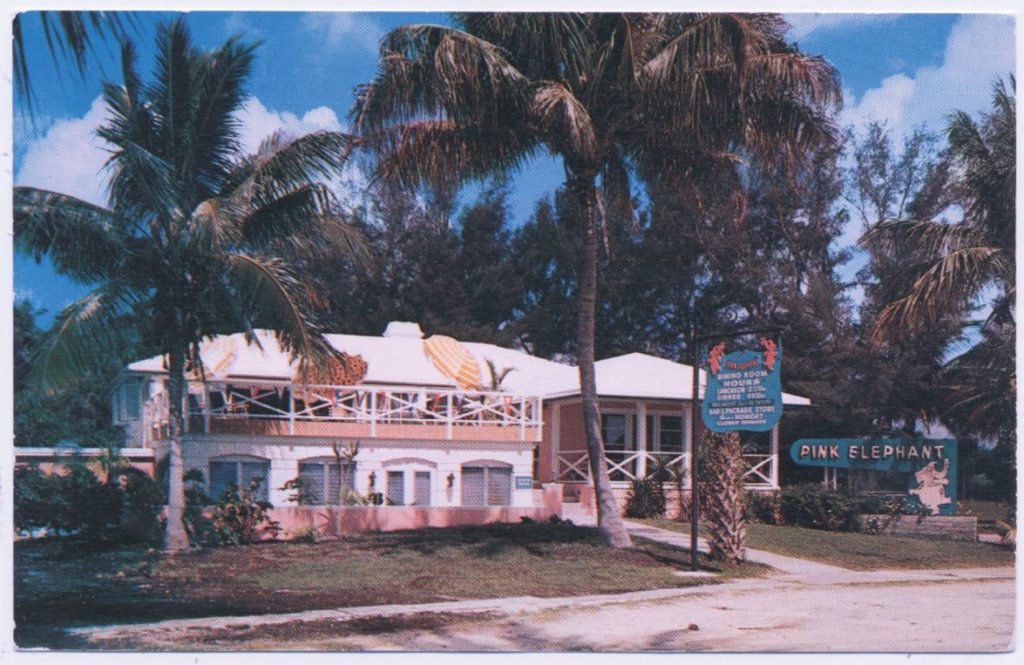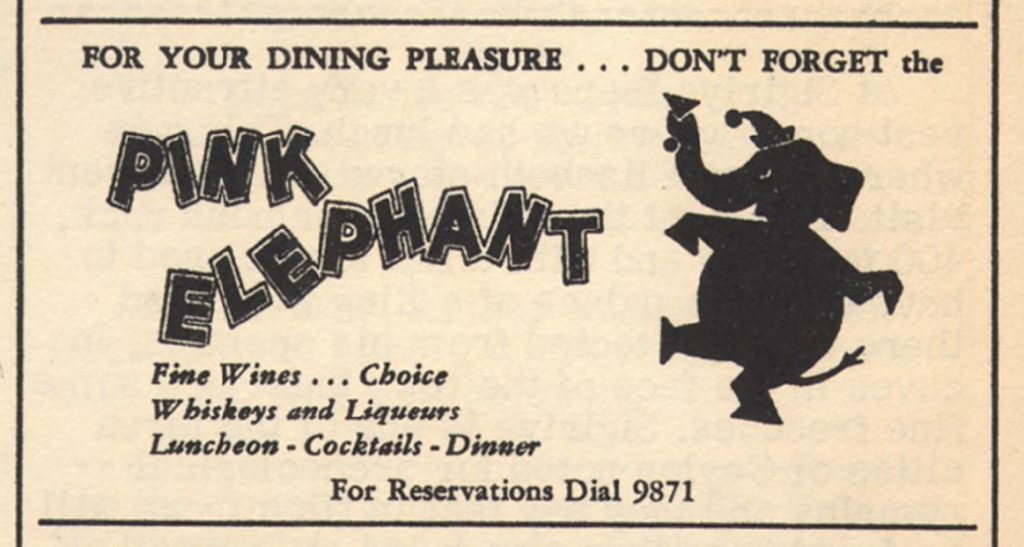From the Boca Grande History Center: Delmar Fugate and the Pink Elephant (Part II of a series)

Submitted by the Boca Grande History Center
In our August 6 edition of the Boca Beacon we ran part I to this series featuring the Fugate family of Boca Grande, compiled from Boca Grande History Center archives. Last time we talked about Jerry Fugate, and this week we introduce you to Delmar Fugate, Jerome’s son.
Delmar Fugate was the youngest son of Ida Will Ormsby and Jerome Fugate. Jerome arrived in Boca Grande in 1909 to work for the commissary at Port Boca Grande and later married Ida Will Ormsby whose family had homesteaded Buck Key near Captiva. Their children were Jerry, Delmar and Elinor who were born in Boca Grande and grew up on Banyan Street. Jerome also had a son, Bryant, whose mother had died as a young woman.
Jerome is remembered for having established Fugate’s Drug Store now simply known as Fugate’s. Both of his sons, Jerry and Delmar, worked at Fugate’s but ultimately Jerry and his wife Geraldine took over the store as detailed in a previous August 6, 2021 Beacon article.
Delmar and his wife, Margaret, built and ran the Pink Elephant, located at the corner of 5th Street and Bayou. Margaret was also a teacher at the Boca Grande School, located in what is now the Community Center. They had two children, Lee and Betsy.
In 1947 Delmar began building the Pink Elephant on the property, which he had purchased from his father. A roofless bar called the Patio had been part of Fugate’s.
According to Betsy Fugate Joiner, “After the war the law said that no alcohol could be sold in such proximity to a church, so they had to shut it down.”
Temporarily Fugate’s package store and bar moved to an old building at the ferry landing. Once the Bayou Street building was complete, the package store and bar moved there.

As Delmar reported in an interview with David Futch, “The Pink was built by hand. We had a one-bag cement mixer and it took a long time to complete. We even had a 75,000-gallon cistern to store rainwater.”
The cistern had to be cleaned and whitewashed every year.
According to Betsy, “Originally, the Pink Elephant wasn’t a restaurant at all. It was a bar and a package store. He (Delmar) was going to call it the Buccaneer, after the fabled pirate Jose Gaspar. He even had glasses for his new business made with a pirate’s face on them. About the time it was going to open, people kept telling him it was going to be a ‘white elephant,’ because it was located so far out of town. As a consequence, it was never called the Buccaneer.”
The Pink part of the name came from the color Delmar painted the new building. Betsy says her father always loved the Bahamas and Cuba, so he chose the pink color for his building. Delmar is said to have explained the color by saying it was the only paint on sale at the hardware store.
Whatever motivated the color, the “white” elephant became the Pink Elephant when it opened in 1949 with a turquoise neon sign that featured a dancing pink elephant wearing a party hat and gripping a martini glass in its trunk.
The message was clear – this was a place to party.
While it may have been located in an area where there were only a few Inn cottages, it was adjacent to the guide docks which lined the bayou between Fourth and Fifth Streets. The fishing guides made the Pink Elephant their headquarters, using the bar’s pay phone to book their charters. The late Mark Futch recalled that Delmar “knew the fishermen would bring their customers to the bar. And they did in droves. He used to have an aquarium with some baby tarpon in it and people would toss in food. When those tarpon started eating, the guides would pour out of the bar and head to the pass with almost dead-on assurance the fish in the pass would be biting.”
The lower level of the Pink Elephant was open on all sides and in response to requests for food, Delmar started to barbecue chickens below the upstairs bar. Louise Crowninshield held the Pink’s first dinner party in 1950 on the patio. Her menu featured stone crabs and fresh local fish served on Margaret Fugate’s personal china. Eventually the downstairs was enclosed and the menu evolved to include sautéed shrimp made with Worcestershire sauce, garlic, light brown sugar, key lime, white wine and a stick of butter per dish as well as freshly made key lime pie and complimentary butterscotch brownies.
Forrest Stover was described by Delmar as “the best bartender I ever saw. He knew every regular customer and what they drank.”

He was also a great storyteller. David Futch reported that … “almost every morning at eight or nine, Stover or Fugate would open the doors to the lounge for thirsty fishermen and guests who spent most of their time gulping the finest Bloody Marys ever. (Fill glass with ice. Sprinkle salt on top. Put Lea & Perrins Worcestershire over the ice, just enough to cover the top. Squeeze in one whole key lime, add vodka and shake.)”
One former bartender tells of a morning when a middle-aged man was pounding on the door at 7 a.m. and pleading, “I need a Bloody.” As the story goes, the bartender complied, explaining, “After all, the man was a Florida Supreme Court Justice.”
Music and dancing to the jukebox were a big part of the Pink. Many customers report that the floor shook when customers in the bar were dancing. Betsy Fugate Joiner learned to dance the jitterbug there to the jukebox tunes, the “Salty Dog Rag” and “Milk Bucket Boogie.”
Delmar Fugate played many other roles in Boca Grande. He was President of the Tarpon Club, a Kiwanis member, a charter member and a member of the board of directors of the Johann Fust Community Library. His wife Margaret was a teacher and the president of the Boca Grande Woman’s Club. She was also a board member of the Boca Grande Historical Society and worked with Nina Houghton and Doris Wheeler to establish the Reference Room at the Community Center (since relocated to the Fust Library) so that island students would have access to computers and other reference materials.
The Fugates sold the original Pink Elephant to Bayard Sharp in 1978. He built the current Pink Elephant which is operated by The Gasparilla Inn. The Fugates also sold their Palm Avenue household property to the developers of the Silver King where they continued to live in a condominium until Delmar’s death in 2000 and Margaret’s in 2013.
This article is based on many previous articles about the Fugates and the Pink Elephant in several island newspapers and magazines, especially those written by David Futch and Marcy Shortuse.
To learn more about the history of Boca Grande and Gasparilla Island, visit the History Center website, bocagrandehistoricalsociety.com, like us on Facebook, visit the History Center at 170 Park Ave. or call 964-1600.
The History Center welcomes input from all. Please send comments or questions to bocagrandehistoricalsociety@gmail.com. This History Center Archives also invites the community to lend photographs, documents or other materials which it will scan and return to the lender.









